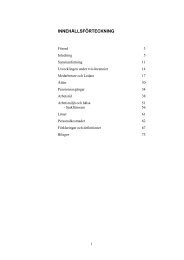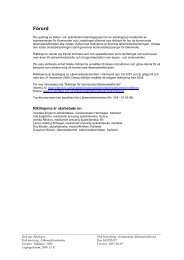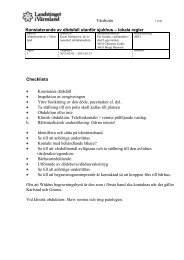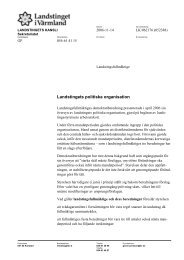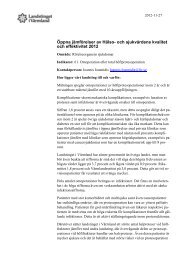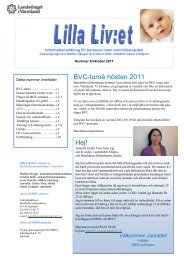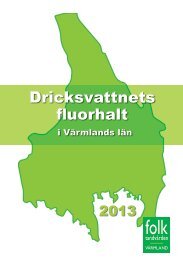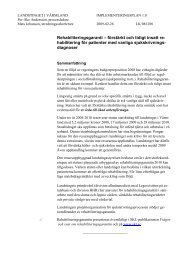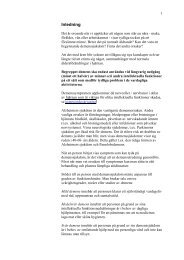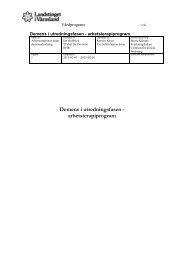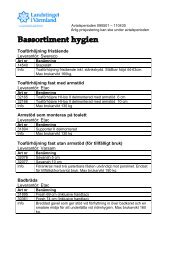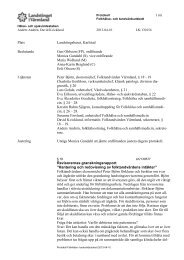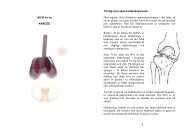Severs skada – paradigmskifte gällande diagnostik och behandling?
Severs skada – paradigmskifte gällande diagnostik och behandling?
Severs skada – paradigmskifte gällande diagnostik och behandling?
You also want an ePaper? Increase the reach of your titles
YUMPU automatically turns print PDFs into web optimized ePapers that Google loves.
Table 3. Peak pressure during standing and running in tested subgroup<br />
Peak pressure, mean (mmHg)<br />
n Shoe<br />
only<br />
Shoe with<br />
cup<br />
Difference<br />
(%)<br />
Standing on heel 10 1407 1056 25<br />
Running 9 1412 1109 21<br />
Fig. 4. Maximal peak pressure during running (three steps)<br />
without cup (upper row) and with cup (lower row) for one<br />
child. Square show area of maximal pressure under forefoot<br />
and hindfoot, respectively. Red color represents the highest<br />
pressure (41385 mmHg).<br />
when using heel cup, with further improvement at<br />
follow-up. The persisting pain with the cup was close<br />
to 0 ( 5 0.5). The reduction in pain level in the non-<br />
A heel cup improves the function of the heel pad<br />
treatment group is thought to reflect the natural<br />
course.<br />
Discussion<br />
This study showed that the use of a heel cup resulted<br />
in increased heel pad thickness and decreased heel<br />
pad peak pressure with corresponding pain relief.<br />
The findings indicate improved heel pad function,<br />
that probably protects the injured heel from further<br />
micro trauma. The very low level of persisting pain<br />
after 4-week treatment with the cup was close to 0<br />
( 5 0.5). These results confirm our results in previous<br />
studies.<br />
The importance of a functional heel box to avoid<br />
overuse injuries in adults was presented by Jo¨ rgensen(1989).<br />
Inspired by the thesis by Jo¨ rgensen, the<br />
former chief at our clinic, Dr. Wessmark, designed<br />
and produced a thermoplastic rigid heel cup with a<br />
2<strong>–</strong>3 cm brim, instead of the traditional cup with its<br />
spoon shape. The ‘‘Wessmark cup’’ has thereafter<br />
been used on this indication. There is no need to<br />
change shoe size because of the added heel cup.<br />
Earlier studies proposing insoles have focused on<br />
the relationship between Sever’s injury, pes equinus<br />
and malalignment. Szames pointed out that equinus<br />
had a definite impact on predisposing a child to<br />
Sever’s disease (Szames et al., 1990). In a retrospective<br />
analysis from his clinic, 482% with Sever’s<br />
injury also had equinus. The primary ambition has<br />
been to normalize the gait/running pattern (Madden<br />
& Mellion, 1996). An excessive pronating foot type is<br />
thought to be associated with poor shock absorption<br />
and therefore contributes to micro trauma of the<br />
heel. This malalignment also may contribute to overactivity<br />
of the calf muscle complex, because of the<br />
necessity to stabilize the talocrural joint and/or to<br />
substitute the eversion of calcaneus. A heel wedge, a<br />
molded plastizote orthosis or a spoon-shaped heel<br />
cup to align the running cycle, have been recommended<br />
from these points of view (Micheli & Ireland<br />
1987; Staheli, 1998; Kasser, 2006). All our children<br />
have been able to walk and stand on their heels with<br />
dorsiflected feet and do not seem to have tight<br />
Achilles tendons, defined as having o101 of dorsiflexion<br />
in the ankle joint, with the knee fully extended.<br />
In an often cited retrospective study by Micheli<br />
and Ireland (1987), the frequency of pronation (without<br />
definition) in a group of 85 patients was 27%.<br />
Almost everyone (98%) was treated with insoles<br />
despite malalignment or not. The insoles used were<br />
soft plastizote orthotic 75%, viscoelastic heel cup<br />
18%, or heel wedge 5%. Approximately 30% in our<br />
studies had unilateral pain. The fact that unilateral<br />
pronation and unilateral short calf muscle seem to be<br />
5<br />
51



